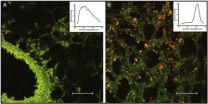Imaging in depth: 3-dimensional microscopy featured in Cold Spring Harbor Protocols
2010-11-02
(Press-News.org) COLD SPRING HARBOR, N.Y. (Mon., Nov. 1, 2010) -- Imaging has rapidly become a defining tool of the current era in biological research. But finding the right method and optimizing it for data collection can be a daunting process, even for an established imaging laboratory. Cold Spring Harbor Protocols is one of the world's leading sources for detailed technical instruction for implementation of imaging methods (http://cshprotocols.cshlp.org/cgi/collection/imaging_microscopy_general), and the November issue (http://cshprotocols.cshlp.org/TOCs/toc11_10.dtl) features articles detailing standard and cutting-edge laboratory techniques.
The confocal microscope is a workhorse of the modern life science laboratory. Its popularity stems from its ability to permit volume objects to be imaged and rendered in three dimensions. But the confocal microscope itself does not produce three-dimensional images; in fact, it only images very thin sections of a specimen that lie within its focal region. To produce a three-dimensional image, a series of thin optical sections are collected, and computer processing is used to combine them into a volumetric rendering. In "Spinning-Disk Microscopy Systems," Oxford University's Tony Wilson (http://acara.eng.ox.ac.uk/som/SOMG_home.html) reviews the many methods for producing optical sections, of which the confocal optical system is just one. He also describes a number of convenient methods of implementation that can lead to, among other things, real-time image formation. The article is freely available on the journal's website (http://cshprotocols.cshlp.org/cgi/content/full/2010/11/pdb.top88).
While confocal microscopy relies on optical sectioning, array tomography is a volumetric microscopy method based on physical serial sectioning. Ultrathin sections of tissue are cut using an ultramicrotome, and attached in order to a glass coverslip. These coverslips are then stained as desired and imaged. The resulting two-dimensional image tiles can then be reconstructed computationally into three-dimensional volume images for visualization and quantitative analysis. The thin sections allow for rapid staining and imaging and the array format allows much of the process to be automated. Stephen J. Smith and colleagues from Stanford University (http://smithlab.stanford.edu/Smithlab/Home.html) present "Array Tomography: High-Resolution Three-Dimensional Immunofluorescence," a guide to this technique that allows for visualizing previously inaccessible features of tissue structure and molecular architecture. The article is freely available on the journal's website (http://cshprotocols.cshlp.org/cgi/content/full/2010/11/pdb.top89).
Both articles are adapted from the forthcoming Imaging: A Laboratory Manual (http://www.cshlpress.com/link/imagingp.htm). Available later this month, the collection is the cornerstone of a new laboratory manual series, designed as an essential guide for investigators who need these visualization techniques.
###
About Cold Spring Harbor Protocols: Cold Spring Harbor Protocols (www.cshprotocols.org) is a monthly peer-reviewed journal of methods used in a wide range of biology laboratories. It is structured to be highly interactive, with each protocol cross-linked to related methods, descriptive information panels, and illustrative material to maximize the total information available to investigators. Each protocol is clearly presented and designed for easy use at the bench—complete with reagents, equipment, and recipe lists. Life science researchers can access the entire collection via institutional site licenses, and can add their suggestions and comments to further refine the techniques.
About Cold Spring Harbor Laboratory Press: Cold Spring Harbor Laboratory Press is an internationally renowned publisher of books, journals, and electronic media, located on Long Island, New York. Since 1933, it has furthered the advance and spread of scientific knowledge in all areas of genetics and molecular biology, including cancer biology, plant science, bioinformatics, and neurobiology. It is a division of Cold Spring Harbor Laboratory, an innovator in life science research and the education of scientists, students, and the public. For more information, visit www.cshlpress.com.
END
ELSE PRESS RELEASES FROM THIS DATE:
2010-11-02
PITTSBURGH, Nov. 1 – Nonsteroidal anti-inflammatory drugs (NSAIDs) prevent colon cancer by triggering diseased stem cells to self-destruct, according to researchers at the University of Pittsburgh Cancer Institute (UPCI) and the University of Pittsburgh School of Medicine. Their findings, reported in the early online version of this week's Proceedings of the National Academy of Sciences, could lead to new strategies to protect people at high risk for the disease.
Doctors have long known that NSAIDs, such as aspirin, can lower the risk of colon cancer, but it's not been ...
2010-11-02
NEW BRUNSWICK, N.J. – An international team of scientists led by Rutgers University astrophysicists have discovered 10 new massive galaxy clusters from a large, uniform survey of the southern sky. The survey was conducted using a breakthrough technique that detects "shadows" of galaxy clusters on the cosmic microwave background radiation, a relic of the "big bang" that gave birth to the universe.
In a paper published in the Nov. 10 issue of Astrophysical Journal, the Rutgers scientists and collaborators at the Pontifical Catholic University of Chile (PUC) describe their ...
2010-11-02
Inappropriate growth and survival signaling, which leads to the aberrant growth of cancer cells, is a driving force behind tumors. Much of current cancer research focuses on the kinase enzymes whose mutations are responsible for such disregulated signaling, and many successful molecularly targeted anti-cancer therapeutics are directed at inhibiting kinase activity.
Now, UCLA researchers from the Crump Institute for Molecular Imaging, the Institute for Molecular Medicine, the California NanoSystems Institute, the Jonsson Comprehensive Cancer Center and the department ...
2010-11-02
COLUMBUS, Ohio – New research suggests that the addition of ultraviolet light to the brushing and suction of a vacuum cleaner can almost double the removal of potentially infectious microorganisms from a carpet's surface when compared to vacuuming alone.
Researchers say the findings suggest that incorporating the germicidal properties of UV light into vacuuming might have promise in reducing allergens and pathogens from carpets, as well.
"What this tells us is there is a commercial vacuum with UV technology that's effective at reducing surface microbes. This has promise ...
2010-11-02
BUFFALO, N.Y. -- Researchers at the University at Buffalo have developed a novel technology using quantum dots that is expected to have major implications for research and treatment of tuberculosis, as well as other inflammatory lung diseases.
A paper appearing online in Nanomedicine: Nanotechnology, Biology and Medicine as an article-in-press describes specific delivery of a chemotherapeutic drug to specific cells in the lung, particularly the alveolar white cell, without causing acute inflammation.
Quantum dots are tiny semiconductor particles generally no larger ...
2010-11-02
Washington, November 1, 2010 – Elderly women are at high risk for inappropriate urinary catheter utilization in emergency departments, according to a new study in the November issue of the American Journal of Infection Control, the official publication of the Association for Professionals in Infection Control and Epidemiology (APIC).
The study was conducted at St John Hospital and Medical Center, a 769-bed tertiary care teaching hospital in Detroit, Mich. The authors examined 532 instances in which urinary catheters were placed in emergency room patients over a 12-week ...
2010-11-02
Along with energy conservation and storm-water reduction, scientists may soon be adding crime-fighting to the list of benefits that urban trees provide. Researchers with the U.S. Forest Service's Pacific Northwest (PNW) and Southern Research Stations have published a new study that suggests that certain types of city trees may help lower property and violent crime rates. Their study—which is posted online in advance of its appearance in a forthcoming printed issue of the journal Environment and Behavior—is the first to examine the effects of trees and other factors on crime ...
2010-11-02
COLUMBIA, Mo. – It may seem difficult to change stereotypical thinking. Perceptions can be very important in forming an individual's attitudes. Now, researchers at the University of Missouri have found that people conditioned to think in opposition to racial stereotypes are more receptive to people from minority groups starring in commercial advertising.
Saleem Alhabash, a doctoral candidate in the University of Missouri School of Journalism.
"This research shows that when people are trained to think in a non-stereotypical way, they will pay more attention to ads with ...
2010-11-02
GMOs, or Genetically Modified Organisms, may raise concerns of genes escaping from crops and having unknown effects on natural, wild species. But what is the real risk that traits associated with GMOs will actually migrate to and persist in their wild relatives? Interest in plant ecology, crop production and weed management led John Lindquist and his colleagues from the University of Nebraska and USDA-ARS to investigate how gene flow from a cultivated crop to a weedy relative would influence the ecological fitness of a cropwild hybrid offspring. They published their findings ...
2010-11-02
WASHINGTON —People aren't very accurate at predicting how good or bad they'll feel after an event -- such as watching their team lose the big game or getting a flat-screen TV. But afterwards, they "misremember" what they predicted, revising their prognostications after the fact to match how they actually feel, according to new research.
These findings appear in the November issue of the Journal of Experimental Psychology: General, published by the American Psychological Association.
Although the process of predicting emotions seems imprecise from start to finish, misremembering ...
LAST 30 PRESS RELEASES:
[Press-News.org] Imaging in depth: 3-dimensional microscopy featured in Cold Spring Harbor Protocols


